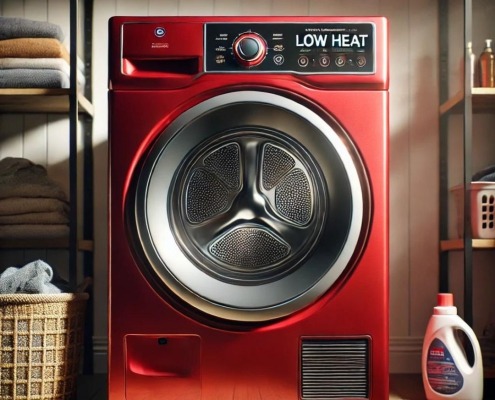How To Replace the Drum Belt On a GE Electric Dryer
Steven E / Friday June 6, 2025
Is your GE dryer belt acting up? We’ll walk you through testing and replacing it if necessary. With our step-by-step instructions, you’ll have your dryer back in working order in no time.
If you need any replacement parts for your GE electric dryer, you can enter your model number at AppliancePartsPros.com to order them. Most orders arrive in just two business days, and we have thousands of free guides to show you how to install your new parts.
The information in this article is based on model DBSR453EB3WW and may not apply to your specific appliance model. We recommend consulting your manufacturer’s documentation or contact us with any questions.
Why you may need to replace your GE dryer belt
Here are those signs of a worn dryer belt:
- Strange noises coming from the dryer, such as squeaking, squealing or grinding
- Clothes taking longer than normal to dry or coming out still damp
- The drum not spinning or spinning slowly/inconsistently
Replacing the dryer belt is a common fix that keeps it working efficiently and prevents more serious issues.
Materials you need
- Phillips screwdriver
- Dryer belt (Make sure it’s compatible with your model)
Safety tips
When working on any appliance, always keep safety first to avoid personal injury or damage to the appliance or its parts. Here are some tips to keep in mind:
- Always power off and unplug your appliance or switch off the circuit breaker before you attempt any maintenance or replacement work. This keeps you safe by eliminating any risk of electric shock.
- If the appliance has recently been used, give it plenty of time to cool down before working on it.
- Take your time while working to prevent accidents and personal injuries. Rushing is the enemy of precision.
- Work in a well-lit area so you can see and access appliance parts.
- Keep your workspace free of clutter and other obstacles. Keep children and pets away from the work area.
- Never work on internal parts with wet hands. Make sure the work area is completely dry.
- Check the user manual to see if there are specific installation or safety instructions related to your appliance or replacement part.
- Be gentle when handling or removing parts. Excessive force might damage the appliance or cause personal injury.
- Wear insulated work gloves to protect your hands from sharp metal parts and debris.
- When working with wires, avoid touching any exposed wires or terminals. If you need to touch a wire, use a non-conductive tool or wear insulating gloves to prevent electrical shock.
- Always take photos or make a note of wiring terminals or other connections before disconnecting them to make reassembly easier.
- Consider wearing safety glasses and/or a dust mask when working with chemicals, dust or a large amount of debris to prevent irritation or injury.
How to replace the dryer belt
- Make sure your dryer is unplugged from the power source.
- Use a Phillips screwdriver to remove the two screws located at the top of the front panel, just behind the door.
- Lift the top panel slightly to clear the console legs and pull it forward. Set the top panel aside.
- Remove the Phillips screws at each back corner of the front panel.
- Before fully removing the front panel, disconnect the door switch wiring. The wiring harness should be carefully unplugged to ensure the door switch remains undamaged.
- Lift the front panel, rotate it to the side, and lean it against the dryer frame. If your belt is broken, it will likely pull free easily. If the belt isn’t broken but has visible flat spots or is stretched out, you will need to remove it from the pulley.
- After detaching it from the pulley, pull the belt forward.
- Slide the new belt around the drum, aligning it with the motor pulley and idler pulley.
- Reach under the drum and secure the belt to the motor. Make sure the idler pulley applies the correct tension to the belt.
- Once the belt is secured, check that all the door switch wires are properly attached.
- Grab the front panel and set it back onto the dryer.
- Secure the front panel with the screws you removed earlier.
- Slide the top panel back onto the console tabs and rotate it down into place.
- Secure the top panel with the long Phillips screws that were removed from behind the door.
- Don’t forget to plug the dryer back in or flip the circuit breaker back on to complete the process.
How to maintain your dryer after installing a new belt
- After every load, clean the lint filter to allow for proper airflow and prevent buildup that could start fires. Remove any lint or debris that’s accumulated in the filter. Rinse and scrub the filter with a mild detergent to remove stubborn debris; make sure it’s completely dry before reinstalling.
- Check the mesh screen of the filter for tears and replace it if it’s damaged.
- Regularly inspect and clean the venting system to ensure it’s free from blockages. Use a vacuum cleaner or a long-handled brush to remove any lint or debris that may have accumulated in the vent housing. Be sure to clean the entire length of the duct and the vent attached to the back of the dryer.
- Clean the drum regularly to remove any accumulated lint or debris. Use a soft brush or a clean cloth to wipe down the interior of the drum.
- Check the door seal (gasket) regularly and replace it if it’s not sealing properly.
- Check the vent hood on the outside of your home for debris and damage. Replace it with a new one if needed. Use a vacuum or cleaning kit with a long-handled brush to remove lint and other debris inside the ducting.
More for you
Thanks for reading! We hope this guide helped you replace the belt on your GE electric dryer.
If you still need some replacement parts, grab your model number and head over to AppliancePartsPros.com. We have over two million parts in stock and most orders arrive in two business days. If you need some help with finding the right part or placing an order, you can contact our team at 1 (877) 477-7278.
While you’re waiting for your new part to arrive, you can explore our DIY blog and watch thousands of video tutorials on our YouTube channel.
Follow us on Facebook, Twitter and Instagram to see our latest repair guides!
With nearly a decade of experience in providing top-notch customer service regarding appliance parts and repair, Steven enjoys sharing practical advice, troubleshooting tips, and interesting information to help readers stay informed.





